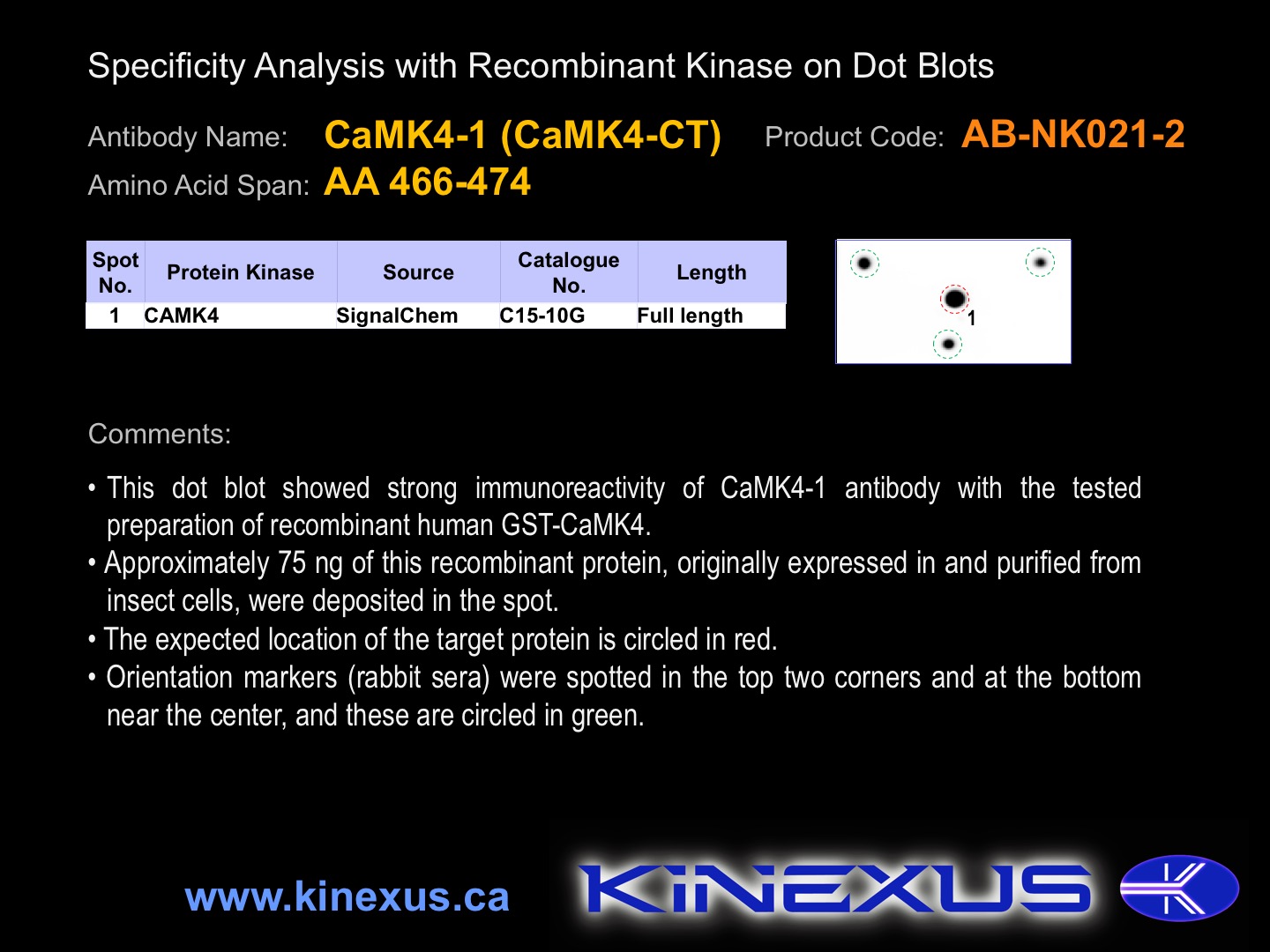Product Name: CaMK4-CT (CaMK4-1 ?)
Product Number: AB-NK021-2
| Size: | 25 µg | Price: | 89.00 | |
| $US |
Target Full Name: Calcium/calmodulin-dependent protein-serine kinase 4
Target Alias: Brain Ca++-calmodulin-dependent protein kinase type IV; Calcium/calmodulin-dependent protein kinase IV; Calcium/calmodulin-dependent protein kinase type IV catalytic chain; Calspermin; CAM kinase- GR; CAM kinase IV; CAM kinase-GR; CaMK IV; CaMK4; Kinase CaMK4; CaMK-GR; CaMKIV; KCC4 CaMK IV; MGC36771; CCDS4103.1; ENSG00000152495
Product Type Specific: Protein kinase pan-specific antibody
Antibody Code: NK021-2
Antibody Target Type: Pan-specific
Protein UniProt: Q16566
Protein SigNET: Q16566
Antibody Type: Polyclonal
Antibody Host Species: Rabbit
Target Alias: Brain Ca++-calmodulin-dependent protein kinase type IV; Calcium/calmodulin-dependent protein kinase IV; Calcium/calmodulin-dependent protein kinase type IV catalytic chain; Calspermin; CAM kinase- GR; CAM kinase IV; CAM kinase-GR; CaMK IV; CaMK4; Kinase CaMK4; CaMK-GR; CaMKIV; KCC4 CaMK IV; MGC36771; CCDS4103.1; ENSG00000152495
Product Type Specific: Protein kinase pan-specific antibody
Antibody Code: NK021-2
Antibody Target Type: Pan-specific
Protein UniProt: Q16566
Protein SigNET: Q16566
Antibody Type: Polyclonal
Antibody Host Species: Rabbit
Antibody Immunogen Source: Human CaMK4 (CaMPK4) sequence peptide
Antibody Immunogen Sequence: CPQQDAILPEY
Antibody Immunogen Description: Corresponds to amino acid residues Q466 to Y474; C-terminus
Antibody Immunogen Sequence: CPQQDAILPEY
Antibody Immunogen Description: Corresponds to amino acid residues Q466 to Y474; C-terminus
Production Method: The immunizing peptide was produced on an A.B.I. automated peptide synthesizer. The peptide was cleaved from the synthesis resin with HF and purified by reverse-phase hplc chromatography. Purity was assessed by analytical hplc and the amino acid sequence confirmed by amino acid analysis. This peptide was coupled to KLH prior to immunization into rabbits. New Zealand White rabbits were subcutaneously injected with KLH-coupled immunizing peptide every 4 weeks. The sera from these animals was applied onto an agarose column to which the immunogen peptide was thio-linked. Antibody was eluted from the column with 0.1 M glycine, pH 2.5. Subsequently, the antibody solution was neutralized to pH 7.0 with saturated Tris.
Antibody Modification: Unconjugated. Contact KInexus if you are interest in having the antibody biotinylated or coupled with fluorescent dyes.
Antibody Concentration: 1 mg/ml
Antibody Modification: Unconjugated. Contact KInexus if you are interest in having the antibody biotinylated or coupled with fluorescent dyes.
Antibody Concentration: 1 mg/ml
Storage Buffer: 100 mM Tris-glycine, pH 7.0
Storage Conditions: For long term storage, keep frozen at -40°C or lower. Stock solution can be kept at +4°C for more than 3 months, but either 0.1% sodium azide or 0.05% Thimerasol should be added. Avoid repeated freeze-thaw cycles.
Product Use: Western blotting | Antibody microarray
Antibody Dilution Recommended: 2 µg/ml for immunoblotting
Antibody Potency: Strong immunoreactivity on Western blots with recombinant mouse calmodulin-dependent protein kinase-4 expressed in sf9 insect cells.
Antibody Species Reactivity: Human; Mouse; Rat
Storage Conditions: For long term storage, keep frozen at -40°C or lower. Stock solution can be kept at +4°C for more than 3 months, but either 0.1% sodium azide or 0.05% Thimerasol should be added. Avoid repeated freeze-thaw cycles.
Product Use: Western blotting | Antibody microarray
Antibody Dilution Recommended: 2 µg/ml for immunoblotting
Antibody Potency: Strong immunoreactivity on Western blots with recombinant mouse calmodulin-dependent protein kinase-4 expressed in sf9 insect cells.
Antibody Species Reactivity: Human; Mouse; Rat
Antibody Positive Control: The observed molecular mass of the processed target protein on SDS-PAGE gels is reported to be around 55-60 kDa.
Antibody Cross Reactivity: In crude rat brain cytosol and membranes, this antibody primarily Western blots proteins of approximately 66 (CaMK4) and 90 kDa.
Related Product 1: CaMK4-pT200 phosphosite-specific antibody (Cat. No.: AB-PK556)
Related Product 2: Autocamtide-2 peptide - CaMK2-derived peptide substrate
Related Product 3: CREB1 (123-135) KinSub - cyclic-AMP response element binding protein-1 (K123-R135, human) peptide; Crebtide protein kinase substrate peptide
Related Product 4: CREB1 (123-135) KinSub, biotinyl. - cyclic-AMP response element binding protein-1 (K123-R135, human) peptide; Crebtide protein kinase substrate peptide
Antibody Cross Reactivity: In crude rat brain cytosol and membranes, this antibody primarily Western blots proteins of approximately 66 (CaMK4) and 90 kDa.
Related Product 1: CaMK4-pT200 phosphosite-specific antibody (Cat. No.: AB-PK556)
Related Product 2: Autocamtide-2 peptide - CaMK2-derived peptide substrate
Related Product 3: CREB1 (123-135) KinSub - cyclic-AMP response element binding protein-1 (K123-R135, human) peptide; Crebtide protein kinase substrate peptide
Related Product 4: CREB1 (123-135) KinSub, biotinyl. - cyclic-AMP response element binding protein-1 (K123-R135, human) peptide; Crebtide protein kinase substrate peptide
Scientific Background: CaMK4 is a protein-serine/threonine kinase of the CaMK group and CaMK1 family. It is a calcium/calmodulin-dependent protein kinase. This kinase is monomeric in structure and occurs in two isoforms generated by alternative splcing from the same gene. It is implicated in immune response, inflammation, memory consolidation, positive selection of T lymphocytes, cytokine production, regulation in neurons and male germ cells, survival and differentiation of osteoblasts and dendritic cells. It is highly expressed in rat tissues such as the forebrain, lymphocytes, spleen, testis, and thymus. Immunohistochemical studies have demonstrated a nuclear localization of the transiently expressed CaMK4. The cytoskeletal and perinuclear localization of inducible CaMK4 implies that the kinase may be a modulator of cell shape and/or motility and/or activity of a cytoskeleton-associated nuclear factor. It regulates many transcription activators such as CREB1, and JUN. It can also activate MAPK pathway through phosphorylation of ELK1 and ATF2. Mutations (S12A, S13A, T57A+K58E, K75E, T200A) are mostly result in loss of phosphotransferase activity or loss of activation by the upstream kinases CaMKK1 or CaMKK2. Some mutations (S189A, H309D+M310E+T312D+F320D+N321D+) lead to a constitutively active form.
© Kinexus Bioinformatics Corporation 2017


